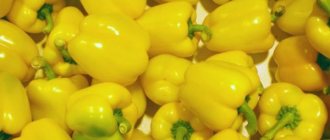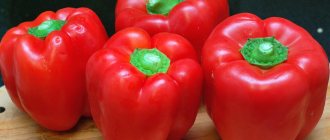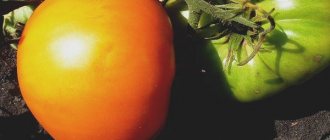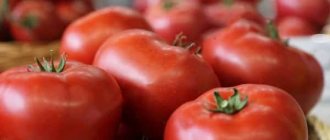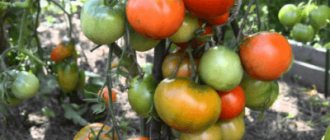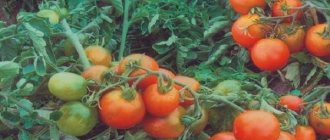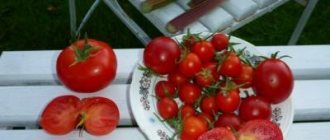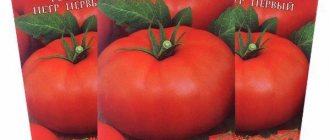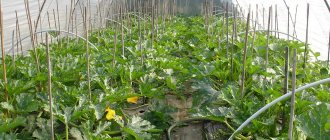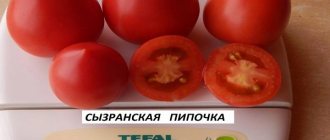Description of the variety
This variety is grown throughout Russia, Moldova and Ukraine; in areas with a harsh climate, “Jupiter” is recommended to be planted in greenhouses; in the southern regions it is planted in open ground. Refers to semi-standard plants, resembles a small tree. Its height can reach 50-60 cm. From one square meter you can harvest 4 kg of crop. You can taste the juicy fruits within 110-120 days after germination.
It has a massive straight stem. The leaves at the top are bright green, the bottom leaves are dark green. The cube-shaped fruits have small bulges at the tip of the pepper, as well as near the tail; the inside is divided into 4 lobes by partitions. At the formation stage, the fruits are green, when ripe they become bright red. The weight of one pepper is approximately 120-170 grams, and the length is approximately 11 cm. The wall can be 5 to 10 mm thick. The skin is smooth and has a waxy coating.
"Jupiter" belongs to a large group of sweet peppers. The taste is sweet, there is no bitterness even in the seeds. They are eaten fresh, for example, in salads, and also added to various dishes and canned; this variety will make an excellent lecho.
Pests and diseases
Diseases
Jupiter is susceptible to tobacco mosaic virus
The consequence of the disease is the risk of losing most of the crop, so attention must be paid to its prevention. It is quite easy to recognize: the leaves of the affected plant acquire an unusual marble pattern.
This virus destroys chlorophyll, thereby finally stopping the process of photosynthesis necessary for plant development.
There are a number of other diseases that threaten Jupiter F1. Phytoplasmosis or bush stolbur appears due to exposure to microorganisms. This disease is spread by insect pests. In the first stages, the leaves of the bush curl and dry out, and over time the entire plant dies. To prevent the possibility of this disease, insect vectors should be controlled. If one of the plants in the seedlings still gets sick, it is destroyed. After harvesting, all equipment is disinfected.
If the planting is too dense and the greenhouse is poorly ventilated, there is a risk of peppers becoming infected with a fungal disease called Blackleg. When this disease appears, the lower part of the stems of the bush turns black and then rots, which leads to the death of the entire plant. If a black leg is detected, the bush is watered with a solution of potassium permanganate.
THE BEST VARIETIES OF SWEET PEPPERS THAT I GROW.
Sweet pepper Review of yield at biological maturity Ch2
Sweet pepper Jupiter. AgroElita
Jupiter F1 pepper seeds (Syngenta), Antifake Part 56
Pests
Aphids suck the juice from the leaves, which leads to drying out of the plant and its underdevelopment. To combat aphids, it is necessary to constantly ventilate the greenhouse, use wormwood tincture and the drug “Phosbecid” to spray diseased plants.
For species that are grown in a greenhouse, spider mites are dangerous. It lives under the leaves of the plant. The leaves of plants affected by the pest become covered with spots, and after a while they dry out and die. The use of pesticides and the removal of plant debris help in controlling this insect.
Growing and care
“Jupiter” belongs to the mid-early plants, so it is necessary to plant seeds for seedlings at the end of February and beginning of March. Sprouts appear within a week, and after 65 days the seedlings can be transferred to a permanent place. Picking pepper is not necessary, because it delays the development of seedlings for 14 days. If you do not pick the plant, then when planting seeds, the distance between them should be at least 10 cm.
Pepper is very heat-loving; the optimal temperature for it during the day is 24-28 degrees, and at night 18-20. At a temperature of 00 C the plant dies. When planting in open soil already in May, it is recommended to cover the plant with agrofibre, because it can still be cool at night. Or you can make a small portable greenhouse and use it before the threat of frost passes. Plant the plant, adhering to the 50 to 40 pattern. The place for planting is of great importance; it is better to plant peppers where onions, cucumbers or cabbage previously grew.
Tip: To strengthen the root system, it is necessary to loosen the soil.
Reacts well to phosphate-potassium fertilizers. The optimal time for watering seedlings is in the morning; it is better to do this with warm water, pouring it at the root. At high temperatures, you should water the plant more often.
If dry leaves appear on a bush, this may indicate a lack of nutrients in the soil, or the influence of unfavorable weather conditions for it, as well as a disease. At the stage of fruit formation, peppers need fertilizing; you can fertilize them with a solution of bird droppings in a ratio of 1:10 or with mullein diluted with water in a ratio of 1:5. After feeding the plant, it is necessary to water and loosen the soil.
The “Jupiter” variety can be stored and tolerates transportation well, maintaining its presentation. Has natural immunity to potato and tobacco mosaic.
Important! With irregular watering during the fruiting period, cracks may appear on the pepper.
A month before the end of the growing season, it is recommended to pinch out new ovaries and sprouts in order to allow already formed fruits to ripen. The crop is harvested at the stage of technical ripeness.
Landing in the ground
Jupiter seedlings are transferred to outdoor growth two to two and a half months after sowing the seeds. This usually happens at the end of May, when really warm and sunny weather sets in. There is no need to rush into planting peppers, as any drop in temperature can cause illness or slow growth of peppers.
Further, until full ripening, it will take another two months, approximately the same amount of time this mid-early variety needs for the fruits to fill with juice, the crust to become hard and thick, and the taste to be enriched.
Proper planting of seedlings and their placement in the garden bed is the key to the healthy growth of strong bushes. The pepper bed is prepared in advance by adding fertilizers to the soil, which will facilitate the rapid development of roots in new conditions. Each pepper bush is planted in a separate hole, into which a complex mineral fertilizer consisting of potassium, phosphorus and nitrogen is placed in advance.
Important: nitrogen fertilizers are needed at the initial stage of growing this crop. It promotes the rapid growth of stems and leaves. Seedlings are not buried deep, a sufficient depth of up to three centimeters, the rhizome must remain close to the surface, otherwise the roots will begin to grow in breadth and will be overgrown with additional shoots that will take away nutrition and moisture to the detriment of fruit formation
The seedlings are not buried deeply, a sufficient depth of up to three centimeters is required, the rhizome must remain close to the surface, otherwise the roots will begin to grow in breadth and will be overgrown with additional shoots that will take away nutrition and moisture to the detriment of fruit formation.
There should be at least 30 centimeters between the bushes so that their rhizomes do not grow together, and each bush receives the portion of nutrients, sun and water it needs. Leave 45-50 centimeters between rows.
Even if peppers are planted in open ground at the beginning of June, it will not be a bad idea to initially protect them from the night cool with the help of temporary shelter. You can build a small greenhouse or cover the bushes with film, as you like.
If the plants grow in an open garden bed, then you should not form bushes. It is better to let the bushes grow large so that the dense foliage saves the pepper from overheating.
Fact: the more leaves there are on the plants, the more shoots will be formed, and accordingly the harvest will be higher.
Reviews
Maria 50 years old Krasnodar region
I have been growing this variety for three years now, and have never regretted it. The fruits grow large and fleshy. They have excellent taste, sweet and juicy. The whole family loves him very much. I make preparations from it for the winter, I just chop it finely in the freezer so that I can add it to different dishes, and I freeze it entirely and then stuff it. It also makes very tasty lecho, thick and aromatic. And adjika is simply delicious! I recommend everyone who loves sweet peppers to grow this variety!
Anatoly 63 years old Taganrog
"Jupiter" is the most excellent variety that I have planted before. The fruits are sweet, fleshy, there is no bitterness at all. Gives a special taste to borscht and soups. My wife freezes it in the freezer for the winter and preserves it in tomato juice and slices. This is my second year planting and I plan to grow it next year.
Anastasia 30 years old Novocherkassk
My neighbor at the dacha treated me to several peppercorns, I really liked the taste, and decided to plant some for myself. The next season I bought seedlings, the harvest was simply magnificent, the fruits were beautiful. I am very pleased!
Fruit characteristics
It was not for nothing that the Jupiter pepper received its famous name in honor of the main Roman god, and at the same time the largest planet in the solar system.
The dimensions of its fruits and their appearance are impressive. The video below shows them in comparison with several other good varieties. The fruits themselves have the following characteristics:
- The shape of the peppers can be called pronounced cuboid, all four edges are so well defined, although somewhat smoothed out. Sometimes, with insufficient lighting, the fruits stretch out a little more than usual, and the shape can become prism-shaped.
- The growth form of the fruit is drooping.
- At the stage of technical maturity, the fruits have a dark green color, and at biological maturity they become rich red, sometimes even dark red.
- The number of seed nests is from two to four.
- The skin is dense, with a waxy coating. The pulp is juicy and crispy.
- Peppers have one of the thickest fruit walls. At the stage of biological maturity it can reach 10 mm.
- The size of the fruit is determined by the growing conditions; on average, the weight of one pepper is 90-120 grams, but can reach 300 grams. In length, as well as in width, the fruits reach 10-11 cm.
- The fruits of Jupiter pepper have an excellent sweet taste even when they are still green.
- They are universal in their uses, although they are most delicious when eaten fresh. They are good in all kinds of culinary dishes and in the form of lecho, marinades and pickles.
- Peppers have an attractive presentation, are uniform in weight, are well preserved and transported, and are therefore good for farming.
- The yields of this hybrid are stable even in conditions that are not the most favorable for pepper.
Read also: Potatoes - Leader - (19 photos): characteristics and description of the variety, taste and reviews
Pepper Jupiter
Mid-season, productive, disease- and weather-resistant Dutch hybrid of sweet pepper. Recommended for growing in open ground and film shelters. The period from germination to the beginning of ripening is 125-128 days.
The bush is erect, strong, semi-standard, 60-80 cm high. The leaf is medium size, dark green to green.
Fruit characteristics
The fruits are drooping, prism-shaped, dark green at the stage of technical ripeness, ruby-red at the biological stage, weighing 130-180 grams, juicy, good taste without bitterness. Wall thickness 5-8 mm. This pepper has a universal purpose - it is suitable for both fresh consumption and canning and home cooking.
Productivity: up to 3 kg of fruits per 1 sq. meters of landings.
Planting pattern: 40 x 50 cm.
Advantages of the hybrid: high yield, excellent taste of fruits, heat resistance, drought resistance.
Pepper Jupiter F1 is included in the State Register of the Russian Federation.
Features of cultivation
Grown through seedlings. Pepper seeds are sown for seedlings in late February-early March. Seedlings are planted in unheated greenhouses in late May - early June.
Bell pepper is responsive to the application of phosphorus-potassium fertilizers for better fruit set and fertilizing with nitrogen fertilizers throughout the growing season. Plants are demanding of soil moisture and low air humidity. Therefore, watering is carried out in the morning with warm water at the root. To develop the root system, regular loosening of the soil should be carried out.
The seeds of this pepper are treated with thiram. Do not soak before sowing!
If you grew Jupiter sweet pepper, please write whether you liked it or not. What was the yield and taste of the fruits like under your climatic conditions? If possible, attach a photo of the pepper.
Your feedback about Jupiter pepper, as well as additions to the description, will help many gardeners evaluate this hybrid objectively and decide whether it is worth planting or not.
Pepper Jupiter F1
Many unlucky gardeners and summer residents, who have tried several times to grow sweet peppers on their plots and suffered a fiasco in this matter, do not despair and try to find a suitable hybrid for themselves. Indeed, hybrids of many vegetables, including sweet peppers, are usually more resistant to adverse environmental factors. In addition, they are bred specifically to improve one or another yield characteristic: fruit size, quantity, wall thickness, sweetness and juiciness. Often, they try to improve many characteristics at once.
But a well-known disadvantage of hybrids is that they are only able to bear fruit for one season. In the future, seeds must be purchased anew every year.
But for many gardeners, including beginners who are not accustomed to collecting and sowing their own seeds, this fact is usually not taken into account, so for them vegetable hybrids may be the best choice
Among the popular hybrids of sweet peppers, the Jupiter F1 pepper is interesting. This hybrid is distinguished by the thickness of the walls of its fruits, which can reach up to 10 mm. In addition, it has many other interesting characteristics that make its cultivation attractive to many gardeners. By the way, one of the advantages of Jupiter F1 pepper, judging by the reviews, is the low price of its seeds, which allows it to be grown by a wide range of fresh vegetable lovers.

